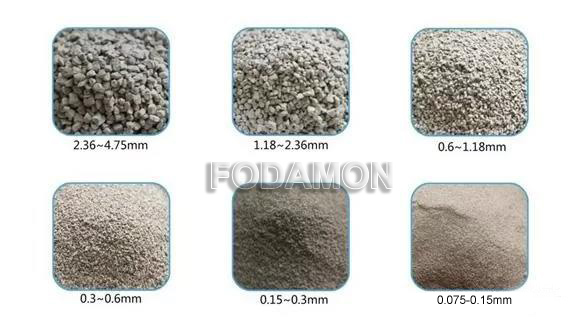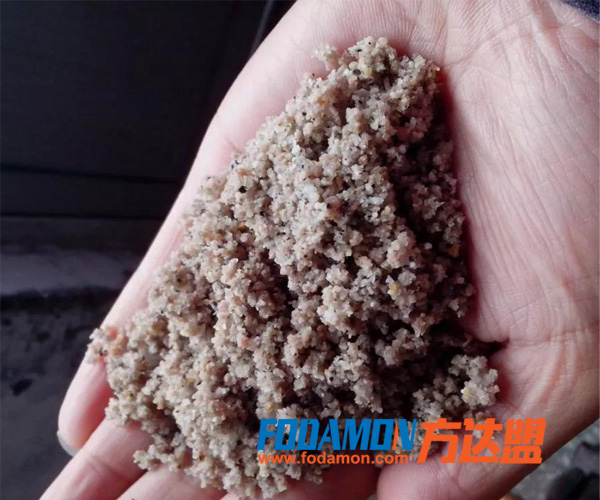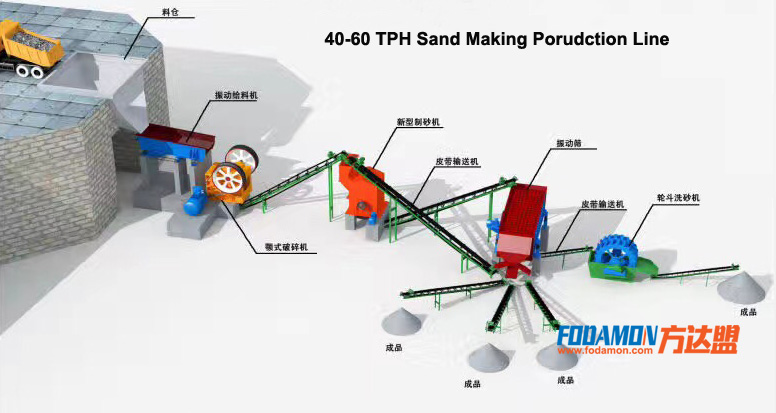Fodamon engineer has accumulated many years’experience in sand and stone crushing and sand making industry, and summarized the following knowledge about sand making for your reference.

- What are the main advantages of dry process?
The main advantages of dry process are as follows:
a, The moisture content of manufactured sand is low, generally less than 2%. Commercial mixed dry mixed mortar can be used directly.
b, The content of stone powder in finished sand can be adjusted and controlled, and centralized recovery can be used comprehensively to reduce dust emission.
c, Little or no water is used in the production process to save water resources and protect the environment;
d, Easy to centralize operation and control, and realize automatic management.
e, Not affected by drought or cold season, it can produce continuously throughout the year.


- Why is the wet process used less and less?
The main reasons are:
a, Consumption of a large amount of water, 1 t of sand and gravel consumes 2-3.5 m of water;
b, The product has a high content of sand and water, which needs to be dehydrated and re-dried for dry mixing.
c, The sand fineness modulus of the product is coarse, and the output of sand is low.
d, It produces a large amount of sludge and sewage, pollutes the environment, and the stone powder is not easy to recover.
e, There are many kinds of capital investment and equipment, and the production cost of machine-made sand is high.
f, It can not produce normally in arid and rainless areas or in freezing season. - What is the methylene blue (MB) value of manufactured sand?
It can be used to determine whether the content of particles smaller than 0.075 mm in manufactured sand is mainly clay or stone powder with the same chemical composition as the processed parent rock. The methylene blue value of manufactured sand requires MB ≤ 1.4, which should be controlled below 1.0. - Why is the fineness modulus of manufactured sand unstable?
In the production process, the lithology, water content and gradation of the feed are easy to change, and the screening process will also have problems such as hole plugging and breakage. The efficiency and parameters of crushing and dust removal equipment are also unstable, which will easily lead to the instability of the fineness modulus of manufactured sand. - Can waste concrete and masonry be used in the production of manufactured sand?
Waste concrete, masonry and industrial waste residue are processed by special equipment through sorting, cleaning, crushing and screening to produce machine-made sand. But at present, it is mainly used to produce recycled coarse aggregate in the industry. - What is the basis of artificial sand production process?
The basis for choosing dry, wet and semi-dry artificial sand production technology is as follows: 1) First of all, it depends on the area where the machine-made sand system is located and the water resources, the cleanliness of raw materials, and the specific requirements for aggregate, machine-made sand powder content and fineness modulus. If the original conditions permit, the dry process is preferred, followed by the semi-dry process, and finally the wet process. 2) Considering the equipment input, the size of the area occupied, the difficulty of production management and the processing cost of manufactured sand and stone, the dry method is also the priority, followed by the semi-dry method, and finally the wet method. - How to sample the mechanism sand?
The general methods for testing and sampling machine-made sand are as follows: 1) When sampling on the stack, the sampling position should be evenly distributed. Before sampling, the surface of the sampling site was removed, and then 8 sand samples were extracted from different parts to form a group of samples. 2) When sampling from the belt conveyor, the feeder is used to extract approximately equal amount of sand at the outlet of the tail of the belt conveyor at regular intervals and form a group of samples. 3) When sampling from trains, automobiles and cargo ships, 8 sand samples of roughly equal amount are drawn from different parts and depths to form a group of samples. - What are the main testing methods for the content of manufactured sand powder?
There are two test methods for the content of machine-made stone powder: washing method and dry sieving method. The representative is ASTM C136 or AASHTOT 27, which is suitable for dry sieving, ASTM C117 or AASHTOT 11, which is suitable for water sieving. However, our country has always been in the cement concrete aggregate or asphalt pavement aggregate, all of them directly use the dry screening method, 0.075mm sieve pass volume is not determined by water washing, so the accuracy is poor. Dry screening method is mainly suitable for aggregate used in cement concrete, and it also needs comprehensive evaluation combined with methylene blue value test results. - What are the main technological methods for separating stone powder?
As far as the development of industry technology and equipment is concerned, at present, the main methods of eliminating excess stone powder in undisturbed sand are water washing hydraulic classification, high frequency screening mechanical screening and dust separation wind classification. - How to adjust the gradation index of manufactured sand?
The gradation of manufactured sand particles can be achieved by adjusting the gradation of feed, feed rate, crusher speed, sieve size and so on. - What factors affect the mechanism sand shape?
The factors affecting the grain shape of manufactured sand are as follows: 1) lithology of source rock, such as development joints, is not conducive to obtaining better grain shape; 2) crushing equipment type, impact crusher shaping effect is better; 3) screen type, such as square hole, is better to control grain shape.
